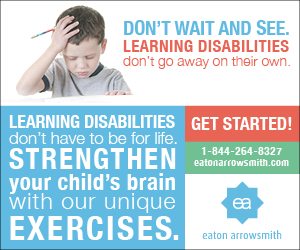Learning tips for kids with anxiety and learning disabilities

 School-related anxiety is common in students especially those with learning disabilities (and even some without!). We talked to Eaton Arrowsmith (EA) on how they (and we as parents can) help kids get calm and focused so they can develop learn and achieve their full potential.
School-related anxiety is common in students especially those with learning disabilities (and even some without!). We talked to Eaton Arrowsmith (EA) on how they (and we as parents can) help kids get calm and focused so they can develop learn and achieve their full potential.
Here are a few tips and strategies.
Accept that failure is part of learning
One reason for student anxiety is fear of failure, said Natalie Poirier, EA’s head academic teacher and math specialist.
Many children feel that their learning disabilities will be with them for life – that if they can’t do something today, they won’t be able to do it tomorrow. In fact, prior to strengthening their brains’ capacity for learning at EA this was often the case. As students create new and stronger pathways for learning it is important for them to embrace mistakes, and learn from them. Otherwise, students’ anxiety only increases and prevents them from engaging in learning.
At EA, “We believe failure, or making mistakes, is part of learning and it’s actually how our brains grow,” Poirier said. Brain science suggests that every time we make a mistake, a new synapse (or connection) is formed.
Adopt a Growth Mindset
At the core of everything EA does is the Growth Mindset. According to Poirier, if you follow the growth mindset, you believe intelligence is malleable and that students can work on their learning disabilities. A fixed mindset is the opposite of the growth mindset. People who think the mind is fixed believe that if something is challenging, it will always be challenging.
“We explain the growth mindset to our students because, if children are afraid of failure, it impacts how they’re willing to engage in difficult tasks,” Poirier said.
Establish a School Routine
At the beginning of every school year, EA teachers establish a classroom culture. Where they outline expected behaviour, develop routines and make the unfamiliar familiar because new places, situations, and patterns often spark milder forms of anxiety.
“It’s normal to feel anxious when our brains are learning something new,” Poirier said.
Practice Mindfulness
To combat anxiety, EA teachers also use mindfulness, which involves having a student take time out from what they’re working on to sit quietly and calmly.
“Engaging in mindful activity helps the prefrontal cortex – the part of the brain that tells the amygdala that a situation isn’t scary and we can still be at rest,” Poirier said. “This activity helps students with anxiety return to class in a happy and relaxed state.”
Continuous stress can do a lot of harm to a student’s confidence, ability to focus and progress.
“We learn best when we’re happy. When we experience anxiety, our brains aren’t as open to learning and forming new pathways,” Poirier said.
Get Exercise
Physicians are now prescribing regular exercise to patients. There are thousands of studies outlining the benefits of regular movement. With screens now a regular part of our kids lives, it’s imperative that they get regular outdoor play and activity. Exercise improves brain and body function, regulate emotions, improve focus, and helps kids sleep well at night.
Take a Look at Eating Habits
In our rush to get kids out the door, off to school and activities, we can neglect healthy eating in favour of quick snacks and processed foods. Balanced meals help regulate emotions and improve brain function and stamina. Think protein, nuts, fruits and veg. Make it a priority.
Get Sleep
Kids need their rest. Sleep directly affects mental and physical development. School-aged kids need a regular and consistent sleep schedule and bedtime routine. Don’t be swayed or pressured by friends and family to keep the kids up late. Get them to bed at the same time every night. Keep the bedroom free of distractions and no screens in the bedroom. When the kids are really wound up, spend several hours of quiet time before bed – a long bath beats MineCraft any day!
This post is sponsored by one of our community builders, Eaton Arrowsmith
At Eaton Arrowsmith we teach our students a series of exercises to help them strengthen their brains and address the cognitive weaknesses that cause their specific learning difficulties. We operate on the principle of neuroplasticity – the brain’s ability to be strengthened over time with targeted training. This sets us apart from other learning intervention programs. www.eatonarrowsmith.com
Harriet Fancott is the Editor and Social Media Manager for Vancouver Mom. She has over 20 years experience in the arts, tech and mom-based blogging arenas. She lives in East Vancouver with her husband and son where they enjoy exploring all that Vancouver has to offer from festivals and events to playgrounds and beaches to sushi and ice cream (although not together).





















